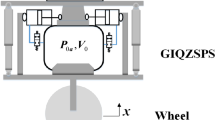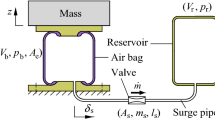Abstract
This research proposes a novel hydro-pneumatic suspension structure based on high-speed on-off solenoid valves, which can realize two spring force modes and four dam** force modes. The basic working principles of the HPS with multiple output force modes are analyzed to establish the dam** and stiffness features mathematical models. Based on the parameters taken from a mine dump truck, the stiffness coefficient and dam** coefficient of the proposed HPS are matched firstly, then the initial charging pressure of accumulators and the diameter of throttle valves are determined. Finally, the validity of the proposed model is demonstrated by comparing the force-displacement and the force-velocity responses of the model with the corresponding measured experimental data under a broad range of excitations.
Similar content being viewed by others
Abbreviations
- f :
-
Natural frequency of suspension
- m u :
-
Sprung mass
- K s :
-
Stiffness of HPS
- P :
-
Instantaneous pressure of accumulator
- P 0 :
-
Initial gas pressure of accumulator
- V :
-
Instantaneous gas volume of accumulator
- V 0 :
-
Initial gas volume of accumulator
- r :
-
Gas polytropic index
- ΔX :
-
Piston position height variation
- ΔV :
-
Gas volume change of accumulator
- S g :
-
Cross sectional area of accumulator
- K g :
-
Stiffness of accumulator
- S 1 :
-
Area of rodless cavity
- ξ :
-
Dam** ratio
- C S :
-
Optimum dam** coefficient
- P 1 :
-
Pressure of rodless cavity
- P 2 :
-
Pressure of rod cavity
- S 2 :
-
Area of rod cavity
- P A0 :
-
Initial pressure of accumulator A
- V A :
-
Instantaneous gas volume of accumulator A
- P A :
-
Instantaneous pressure of accumulator A
- V A0 :
-
Initial gas volume of accumulator A
- X :
-
Displacement of piston
- P B :
-
Instantaneous pressure of accumulator B
- P B0 :
-
Initial pressure of accumulator B
- V B :
-
Instantaneous gas volume of accumulator B
- V B0 :
-
Initial gas volume of accumulator B
- F k1 :
-
Soft elastic force
- K 1 :
-
Soft stiffness
- F k2 :
-
Hard elastic force
- K 2 :
-
Hard stiffness
- Q :
-
Oil flow through damper valve
- C d :
-
Discharge coefficient
- ρ :
-
Oil density
- A z4 :
-
Area of throttle hole 4
- A z5 :
-
Area of throttle hole 5
- A z6 :
-
Area of throttle hole 6
- A d :
-
Hole area of check valve
- F :
-
Output force of HPS
- F c1 :
-
Dam** force of mode 1
- F c2 :
-
Dam** force of mode 2
- F c3 :
-
Dam** force of mode 3
- F c4 :
-
Dam** force of mode 4
- F S :
-
Maximum static output force
- d :
-
Piston rod diameter
- D :
-
Cylinder diameter
- λ d :
-
Ratio value of piston rod outer diameter to hydraulic cylinder diameter
References
Z. Li, X. Chen, X. Song and H. Xue, Analysis of vertical dynamic characteristics of hub direct drive air suspension system, Journal of Jiangsu University (Natural Science Edition), 43(1) (2022) 8–14.
X. Meng, Z. Sun, R. Ding, R. Wang and L. Chen, Energy-saving mechanism and experiment of hybrid electromagnetic active suspension based on improved skyhook control, Journal of Jiangsu University (Natural Science Edition), 41(6) (2020) 627–633.
W. Tao and Z. Liu, Seat suspension control of wheel loader based on dam** state switching, Journal of Jiangsu University (Natural Science Edition), 40(5) (2019) 504–510.
K. Kwon, M. Seo, H. Kim, T. H. Lee, J. Lee and S. Min, Multi-objective optimization of hydro-pneumatic suspension with gas-oil emulsion for heavy-duty vehicles, Vehicle System Dynamics, 58(7) (2020) 1146–1165.
J. Yang, C. Y. Duan, W. M. Zhang, Y. H. Shen and H. X. Zhou, Experimental research and mathematical model on pressure characteristics of throttle hole of hydro-pneumatic suspension, 2020 WASE International Conference on Information Engineering, Beidai (2010) 208.
K. Sim, H. Lee, J. W. Yoon, C. Choi and S. H. Hwang, Effectiveness evaluation of hydro-pneumatic and semi-active cab suspension for the improvement of ride comfort of agricultural tractors, Journal of Terramechanics, 69 (2017) 23–32.
S. Y. Wang, X. L. Li, and G. J. Yang, Simulation on over-obstacle characteristic of a mining truck with hydro-pneumatic suspensions, Vehicle & Power Technology, 2 (2012) 26–29.
H. Qi, Y. Chen, N. Zhang, B. Zhang, D. Wang and B. Tan, Improvement of both handling stability and ride comfort of a vehicle via coupled hydraulically interconnected suspension and electronic controlled air spring, Proceedings of the Institution of Mechanical Engineers, Part D: Journal of Automobile Engineering, 234(2–3) (2020) 552–571.
M. R. Ahmed, A. R. Yusoff and F. R. M. Romlay, Adjustable valve semi-active suspension system for passenger car, International Journal of Automotive and Mechanical Engineering, 16(2) (2019) 6470–6481.
X. Q. Sun, L. Chen and S. H. Wang, Performance investigation of vehicle suspension system with nonlinear ball-screw inerter, International Journal of Automotive Technology, 17(3) (2016) 399–408.
M. A. A. Abdelkareem, A. B. M. Eldaly, M. K. A. Ali, I. M. Youssef and X. Lin, Monte Carlo sensitivity analysis of vehicle suspension energy harvesting in frequency domain, Journal of Advanced Research, 24(1) (2020) 53–67.
D. Lin, F. Yang, D. Gong and S. Rakheja, Design and experimental modeling of a compact HPS strut, Nonlinear Dynamics, 100(4) (2020) 307–3320.
T. Raparelli, A. M. Bertetto and L. Mazza, Experimental and numerical study of friction in an elastomeric seal for pneumatic cylinders, Tribology International, 30(7) (1997) 547–552.
H. M. Djavareshkian, A. Esmaeli and H. Safarzadeh, Optimal design of magnetorheological fluid damper based on response surface method, International Journal of Engineering Transactions B: Applications, 28(9) (2015) 1030–1039.
N. J. Theron and P. S. Els, Modelling of a semi-active hydropneumatic spring-damper unit, International Journal of Vehicle Design, 45(4) (2007) 501–521.
R. Ahamed, M. M. Rashid, M. M. Ferdaus and H. M. Yusof, Design and modeling of energy generated magneto rheological damper, Korea Australia Rheology Journal, 28(1) (2016) 67–74.
X. Sun, Y. Cai, S. Wang, Y. Liu and L. Chen, A hybrid approach to modeling and control of vehicle height for electronically controlled air suspension, Chinese Journal of Mechanical Engineeringl, 29(1) (2016) 152–162.
P. Karimi, A. Khajepour, A. Wong and M. Ansari, Analysis and optimization of air suspension system with independent height and stiffness tuning, International Journal of Automotive Technology, 17(5) (2016) 807–816.
N. Jiao, J. Guo and S. Liu, Hydro-pneumatic suspension system hybrid reliability modeling considering the temperature influence, IEEE Access, 5 (2017) 19144–19153.
W. Yu and Y. Zhou, Cooperative control of dam** and body height based on model prediction, Journal of Jiangsu University (Natural Science Edition), 42(5) (2021) 513–519.
G. Pan, C. Ding, W. Wang and A. Li, Application of extended zero moment point in vehicle pitch control evaluation and active control, Journal of Jiangsu University (Natural Science Edition), 42(1) (2021) 85–91.
X. Zhang, H. He, J. Nie and L. Chen, Performance analysis of semi-active suspension with skyhook-inertance control, Journal of Jiangsu University (Natural Science Edition), 39(5) (2018) 497–502.
K. Kahraman, Y. Kemal, A. Bilge and M. Huseyin, Modelling and optimisation of an 8×8 heavy duty vehicle’s hydropneumatic suspension system, International Journal of Vehicle Design, 71(1–4) (2016) 122–138.
S. H. Zhang and B. Z. Lv, Simulation on output force characteristics of dam**-adjustable HPS, IEEE Intelligent Vehicles Symposium (2009) 1291–1296.
Y. M. Yin, S. Rakheja, J. Yang and P.-E. Boileau, Characterization of a HPS strut with gas-oil emulsion, Mechanical Systems and Signal Processing, 106(1) (2018) 319–333.
G. S. Heymans, J. F. Grobler and P. S. Els, Physics based modelling of a magneto-rheological equipped hydro-pneumatic semi-active suspension system, ASME International Design Engineering Technical Conferences and Computers and Information in Engineering Conferences (2016) DETC 2016–59922.
X. Wu, H. Zhang, D. Du, Z. Han and J. Zhao, Analysis of instantaneous pressure in oil return stage of electro-hydraulic variable valve system, Journal of Jiangsu University (Natural Science Edition), 41(2) (2020) 206–213.
D. Song, F. Dong, Z. Cheng and J. Wan, Performance analysis of battery cooling system based on mini-channel cold plate, Journal of Jiangsu University (Natural Science Edition), 42(3) (2021) 264–270.
A. Tiwari and A. Pathak, Design and performance analysis of mechanical hydro-pneumatic suspension system, International Research Journal of Engineering and Technology, 4(6) (2017) 1929–1932.
J. Yang, S. Chen, Z. Wu, Y. Zhao and B. Yang, Design and testing on the HPSs with controllable stiffness and dam**, Transactions of the Chinese Society for Agricultural Machinery, 39(10) (2008) 20–24.
S. Li, P. Du and X. Feng, Integrated anti-rollover control strategy of minibus, Journal of Jiangsu University (Natural Science Edition), 43(2) (2022) 131–138.
Y. Sun and Z. Wu, Dynamic parameter matching schemes of three-axis vehicles suspension, Journal of Jiangsu University (Natural Science Edition), 39(3) (2018) 249–253.
Acknowledgments
This work was supported by the National Key Research and Development Program of China (Project No. 2020YFC1512403) and the International Science and Technology Cooperation Program of Jiangsu Province (Project No BZ2022055).
Author information
Authors and Affiliations
Corresponding author
Additional information
Chunfang Yin received the B.Sc. degree in Electrical Engineering, and the M.Sc. and Ph.D. degrees in Control Theory and Control Engineering from Jiangsu University, Zhenjiang, China, in 1999, 2004, and 2019, respectively. She is currently an Associate Professor with the School of Electrical and Information Engineering, Jiangsu University, Zhenjiang, China. Her research interests mainly include advanced suspension systems and dynamics control.
Xuhui Zhai received the Bachelor’s degree in Vehicle Engineering from Inner Mongolia University of Science and Technology in Baotou, China in June 2017, and is currently studying for a Master’s degree in Vehicle Engineering. His research interests include hydro pneumatic suspension.
**%20and%20stiffness%20characteristics&author=Chunfang%20Yin%20et%20al&contentID=10.1007%2Fs12206-022-0905-0©right=The%20Korean%20Society%20of%20Mechanical%20Engineers%20and%20Springer-Verlag%20GmbH%20Germany%2C%20part%20of%20Springer%20Nature&publication=1738-494X&publicationDate=2022-10-03&publisherName=SpringerNature&orderBeanReset=true">Reprints and permissions
About this article
Cite this article
Yin, C., Zhai, X., Sun, X. et al. Design and performance research of a hydro-pneumatic suspension with variable dam** and stiffness characteristics. J Mech Sci Technol 36, 4913–4923 (2022). https://doi.org/10.1007/s12206-022-0905-0
Received:
Revised:
Accepted:
Published:
Issue Date:
DOI: https://doi.org/10.1007/s12206-022-0905-0




